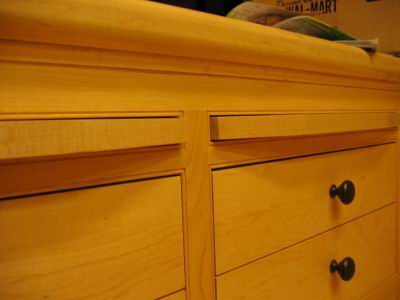Bullnose Stair Tread Returns
Several ways to get a perfect return. April 14, 2005
Question
Here is the situation: 1" Santos mahogany treads, approximately 40 of them, open on one side, need returns installed on them (jack mitered). Treads are one piece where the owner does not want to see a bull nose piece glued on the front of the tread. Does anyone have any suggestions on how to cut or miter these ends on? I thought about creating a template using the monster 3-1/4 hp router to route the end, then apply nosing. How do I handle the radius created? If anyone has any ideas please let me know. I could do it the old fashioned way - fight, cuss and fill. There are enough treads in this job to warrant coming up with some ingenious idea.
Forum Responses
(Cabinet and Millwork Installation Forum)
From contributor A:
I'm not sure if I follow you. Do you need to add the bullnose on the end of the tread, on the front edge, or both?
From contributor B:
I have used a template like you said to rout the main tread. You can chisel out the rounded inside corner (there is much less excess to remove than you might think) and then fiddle around with the fit of each return. Or you can do as I prefer to do, and fit another template to the rounded corner tread, and pattern cut all the returns as well. Also when I do this I use a 3/4 bottom bearing bit that I have also added top bearings to. This way I can use it as top or bottom bearing bit and alternate the side of the tread/return that I put the template on, so that I never end up with tearout on the outside miter of the joint.
From contributor C:
Mill the bullnose on the front edge of the treads and on a length of stock for the returns. Stack all the treads lining up the front edges perfectly and clamp them together. Using a straight edge and a circular saw set to 45% cut all the miters with the deck of the saw resting on the end of the treads (this works best if all the treads are stacked standing on end). Then finish the end cut with a sliding miter saw or circular saw with straight edge. Finish this cut with a hand saw. You’ll get perfect returns every time. I hope I'm making sense. This is harder to explain than I thought.
From contributor D:
That's a good idea, however I got used to do them on the tablesaw and when I do radius I look first at the blueprint for the spec's radius and I build a special jig to match the returns to the radius of the staircase.
From contributor E:
Two ways that work for me - first the router method: make a jig as you mention, use jig to mark tread then cut to 1/8 or so with jigsaw, route with jig. This leaves a bit of a radiused miter. Then cut the return with mitered end, take to stationary belt sander and round the miter a bit to fit. After a couple test runs, you'll get the roundover right on. Glue and nail at front and 2/3 way back.
For a standard type miter, I put a 2 /14" spacer against fence on my SCMS, set up slide lock knob to cut a miter that ends at just slight of 1-1/4 ( the standard return and overhang). The cut will be longer on bottom (I'm cutting tread upside down by the way). Clean to line if needed with a Jap hand saw (very thin kerf and super cut). Then cut to miter intersection with fence set up on band saw (may have to cut upside down if return is for R side), miter return stock and install as mentioned. On both methods I've already done the router radius cuts on the treads and return stock.
From contributor F:
I use homemade sleds on my table saw to cut the treads - a cross-cut sled for the straight cut, carefully stopping at the short point of the miter – and a 45 V-sled for the short 45, again stopping at the intersection. On both cuts the blade is fully raised to reduce the undercut so be cautious. You also need to back out of these cuts, which is no problem with a good sled and clamps. To attach the returns I use a full spline. Biscuits can't reach into the miter. Hopefully there is a picture below of my original return and an improved replacement. The sleds work very well and I can turn out near perfect joints on the treads with little effort and no cussing or filling. I did 30 treads on my last stair. Of course I am leaving out a lot of detail. I'm thinking you already know how to set up jigs, check alignment and sequence milling operations.
